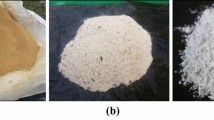Abstract
The paper addresses certain issues pertaining to the technology of lime-stabilised steam-cured blocks used for masonry construction. Properties of lime-stabilised steam-cured blocks using expansive soils and tank bed soils have been examined. Influence of parameters like steam curing period, lime content and fly ash content on wet strength of blocks is studied. Steam curing of lime stabilised blocks at 80°C for about 20 hours at atmospheric pressure leads to considerably higher strengths when compared with curing under wet cloth at ambient temperatures. Clay-fly ash fractions of the mix control the optimum lime content yielding maximum strength. Long-term strength behaviour of steam-cured blocks has been monitored. The results indicate a favourable lime-clay ratio for stable long-term strength. A small-scale steam cured block production system has been designed and implemented to construct a load bearing masonry structure, thus demonstrating the potential of steam-cured block as a material for masonry construction.
Résumé
L'article traite de certains problèmes liés à la technologie des blocs stabilisés à la chaux et curés à la vapeur, que l'on utilise en maçonnerie. On a examiné les propriétés de ces blocs en utilisant des terres expansives et des terres issues de réservoirs. L'influence des paramètres tels que le temps de maturation, le volume de chaux, le volume de cendres volantes sur la résistance de blocs face à l'humidité a été étudiée. La maturation par la vapeur des blocs stabilisés à la chaux à 80°C pendant environ 20 heures en pression atmosphérique conduit à des résistances considérablement plus fortes que pour la maturation obtenue à l'aide de tissus humides à températures ambiantes. des fractions d'argile et de cendres volantes du mélange contrôlent le volume optimal de chaux produisant une résistance maximale. Le comportement relatif à la résistance à long terme des blocs curés à la vapeur a été enregistré. Les résultats, indiquent un rapport chaux-argile allant dans le sens d'une résistance à long terme stable. Un système de production de blocs curés à la vapeur à une échelle réduite a été élaboré et mis en place afin de construire un ouvrage de maçonnerie avec élément porteur, démontrant ainsi le potentiel d'un bloc curé à la vapeur comme matériau de construction.
Similar content being viewed by others
References
Jagadish, K. S., ‘The progress of stabilised soil construction in India’, Proceedings of National Seminar on Application of Stabilised Mud Blocks in Housing and Building, Bangalore, India, Nov. 1988, 17–43.
Walker, P., Venkatarama Reddy, B. V., Mesbah, A. and Morel, J.-C., ‘The case for compressed earth block construction’, Proceedings of 6th International Seminar on Structural Masonry for Developing Countries, Bangalore, India October 2000 (Allied Publishers Ltd.) 27–35.
Houben, H. and Guillaud, H. ‘Earth construction: a comprehensive guide’ (IT Publications, London, 1994).
Venkatarama Reddy, B. V., ‘Studies on static soil compaction and compacted soil-cement blocks for walls’, Ph. D. thesis, Dept. of Civil Engineering, Indian Institute of Science, Bangalore, India, (1991)
Venkatarama Reddy, B. V. and Jagadish, K. S., ‘Influence of soil composition on the strength and durability of soil-cement blocks’,The Indian Concrete Journal 69 (9) (1995) 517–524.
Lunt, M. G., ‘Stabilised soil blocks for building construction’,Overseas Building Notes (184) (February 1980).
Walker, P., ‘Strength, durability and shrinkage characteristics of cement stabilised soil blocks’,Cement & Concrete Composites 17(4) (1995) 301–310.
Fitzmaurice, R., ‘Manual on stabilised soil construction for housing’, United Nations, New York, USA, (1958).
Venkatarama Reddy, B. V., and Lokras, S. S., ‘Steam-cured stabilised soil blocks for masonry construction’,Energy and Buildings 29 (1998) 29–33.
Mateos, M. and Davidson, D. T., ‘Steam hardening of lime, lime and fly ash and cement treated soil’, for presentation at the 73rd session of the IOWA Academy of Sciences, Indiana, IOWA, (April 1961), 14–15.
Mateos, M., ‘Soil lime research at IOWA State University’,Journal of Soil Mechanics and Foundation Division, ASCE 90 (SM2) (1964) 127–153.
Ladd, C. C., Moh, Z. C. and Lambe, T. W., ‘Recent soil lime research at M. I. T.’Highway. Research Board Bulletin 262 (1968).
Ranganatham, B. V. and Pandyan, N. S., ‘Strength gain in thermally cured lime stabilised clays’, Proceedings of 4th conference on Soil Mechanics, Budapest, 1971, 263–272.
Venkatarama Reddy, B. V. and Jagadish, K. S., ‘Pressed soillime blocks for building construction’,Masonry International 3 (1984) 10–16.
Venkatarama Reddy, B. V. and Jagadish, K. S., ‘The static compaction of soils’,Geotechnique 43 (2) (1993) 337–341.
Herrin, M. and Mitchell, H., ‘Lime soil mixtures’, Highway Research Board, National Research Council, Washington D. C., U. S. A., Bulletin No. 304, (1961).
Thompson, M. R., ‘Lime reactivity of Illinois soils’,Journal of Soil Mechanics and Foundations Division, ASCE,92 (SM5) (1966) 67–92.
Yong, R. N. and Warkentin, B. P., ‘Soil properties and behaviour’, (Elsevier Scientific Publishing Co., New York, 1975).
Sridharan, A., Rao S. M. and Satyanarayama Murthy, N., ‘A rapid method to identify clay type in soils by the free swell technique’,ASTM Geotechnical Testing Journal 9(4) (1986) 198–203.
Author information
Authors and Affiliations
Rights and permissions
About this article
Cite this article
Venkatarama Reddy, B.V., Hubli, S.R. Properties of lime stabilised steam-cured blocks for masonry. Mat. Struct. 35, 293–300 (2002). https://doi.org/10.1007/BF02482135
Received:
Accepted:
Issue Date:
DOI: https://doi.org/10.1007/BF02482135




